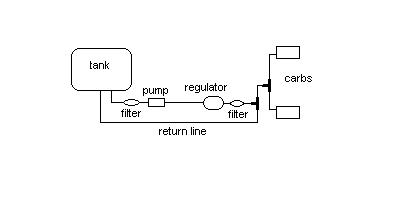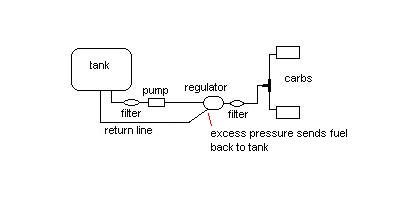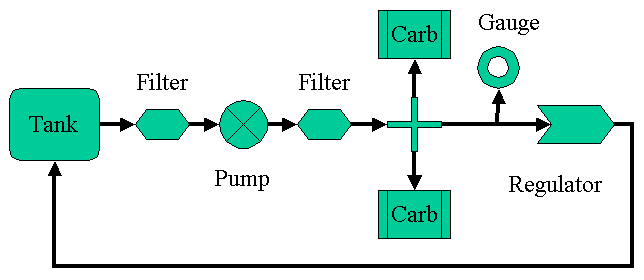|
|

|
Porsche, and the Porsche crest are registered trademarks of Dr. Ing. h.c. F. Porsche AG.
This site is not affiliated with Porsche in any way. Its only purpose is to provide an online forum for car enthusiasts. All other trademarks are property of their respective owners. |
|
|
  |
| scruz914 |
 Jan 24 2005, 07:13 PM Jan 24 2005, 07:13 PM
Post
#1
|
|
Senior Member    Group: Members Posts: 815 Joined: 26-February 04 From: Santa Cruz, CA Member No.: 1,724 |
I have the engine out and started cleaning up around the engine compartment. I removed some thick, dried out black gunk impregnated, wrapping around the fuel lines where they run from the firewall to the engine shelf. I guess the wrapping was for protection. Anyway, under the wrapping I see that the return line is plugged with a screw. The fuel line runs to a filter under the shelf, then to a cheap-o (but works) regulator in the engine compartment, followed by another filter, then to a T, and finally to the carbs. I have no idea what the plumbing is under the fuel tank in the front. I have carbs, the fuel pump is in the front, and the engine runs fine. Should the return line be operational? What is its function? I am guessing it is related to FI and not carbs.
-Jeff |
| brant |
 Jan 24 2005, 07:21 PM Jan 24 2005, 07:21 PM
Post
#2
|
|
914 Wizard           Group: Members Posts: 11,623 Joined: 30-December 02 From: Colorado Member No.: 47 Region Association: Rocky Mountains 

|
yes the return is for a fuel injection system.
you can run without it.. having said that It is still better to have a return on a carbed car than not (cools the fuel more... more HP) |
| scruz914 |
 Jan 24 2005, 07:26 PM Jan 24 2005, 07:26 PM
Post
#3
|
||
|
Senior Member    Group: Members Posts: 815 Joined: 26-February 04 From: Santa Cruz, CA Member No.: 1,724 |
Return from what point? Just before the T splitting the line to the carbs? |
||
| SpecialK |
 Jan 24 2005, 07:28 PM Jan 24 2005, 07:28 PM
Post
#4
|
||
|
aircraft surgeon     Group: Benefactors Posts: 3,211 Joined: 15-March 04 From: Pacific, MO Member No.: 1,797  |
(IMG:http://www.914world.com/bbs2/html/emoticons/huh.gif) I always thought that FI cars required the return line to bleed off pressure from the fuel pump. And that carbed cars didn't need a return line because of the low (2-4psi) pressure required to keep the carbs fed. |
||
| scotty b |
 Jan 24 2005, 07:32 PM Jan 24 2005, 07:32 PM
Post
#5
|
|
rust free you say ?                Group: Members Posts: 16,375 Joined: 7-January 05 From: richmond, Va. Member No.: 3,419 Region Association: None |
Fuel filters for V8 jeeps ( grand wagoneer) have a single inlet and a dual outlet, one being for the return line. I understand it is basically to bleed off any unused pressure instead of forcing it to the carb. (IMG:http://www.914world.com/bbs2/html/emoticons/confused24.gif)
|
| airsix |
 Jan 24 2005, 09:36 PM Jan 24 2005, 09:36 PM
Post
#6
|
|
I have bees in my epiglotis     Group: Members Posts: 2,196 Joined: 7-February 03 From: Kennewick Man (E. WA State) Member No.: 266 |
Even if you use carbs, I'd run a return line if you live in a hot climate. Less chance of vapor lock if you keep the hot fuel circulating back to the tank.
-Ben M. |
| SpecialK |
 Jan 24 2005, 10:25 PM Jan 24 2005, 10:25 PM
Post
#7
|
||
|
aircraft surgeon     Group: Benefactors Posts: 3,211 Joined: 15-March 04 From: Pacific, MO Member No.: 1,797  |
Where would the return line come from assuming that you're running dual carbs. After the tee obviously........hmmmm...I need someone to draw me a picture of this set-up! (IMG:http://www.914world.com/bbs2/html/emoticons/unsure.gif) |
||
| 914GT |
 Jan 24 2005, 10:36 PM Jan 24 2005, 10:36 PM
Post
#8
|
|
Senior Member    Group: Members Posts: 1,100 Joined: 11-October 04 From: Tucson Member No.: 2,923 Region Association: Southwest Region |
The original return line came off the bypass valve on the fuel pump. This is a spring-loaded relief valve that regulates the output pressure. I don't think you'll be able to use a return line unless your external regulator works in a similar fashion. If you run a return after your pump, you need some means to limit the return flow otherwise you'll never have sufficient fuel pressure.
|
| scruz914 |
 Jan 24 2005, 10:45 PM Jan 24 2005, 10:45 PM
Post
#9
|
||||
|
Senior Member    Group: Members Posts: 815 Joined: 26-February 04 From: Santa Cruz, CA Member No.: 1,724 |
That is what I am wondering. I think it would be just before the T to the carbs. If after the T then you would have to run a return from each line to the carbs. Something like this. Attached image(s) 
|
||||
| scruz914 |
 Jan 24 2005, 10:47 PM Jan 24 2005, 10:47 PM
Post
#10
|
||
|
Senior Member    Group: Members Posts: 815 Joined: 26-February 04 From: Santa Cruz, CA Member No.: 1,724 |
That makes sense. I think my diagram is wrong then. |
||
| 914GT |
 Jan 24 2005, 10:48 PM Jan 24 2005, 10:48 PM
Post
#11
|
|
Senior Member    Group: Members Posts: 1,100 Joined: 11-October 04 From: Tucson Member No.: 2,923 Region Association: Southwest Region |
So, how will you be able to keep about 5 psi at the carbs with an open line back to the tank?
By the way, I'm not using the return line on my V8 with stock mechanical pump. I had some vapor-locking problems but was due to the carburetor getting too hot. You don't have quite the same situation as you have a blower moving air in the engine compartment. |
| scruz914 |
 Jan 24 2005, 10:53 PM Jan 24 2005, 10:53 PM
Post
#12
|
||
|
Senior Member    Group: Members Posts: 815 Joined: 26-February 04 From: Santa Cruz, CA Member No.: 1,724 |
You couldn't. The diagram would have to look like this. Attached image(s) 
|
||
| Reiche |
 Jan 25 2005, 12:21 AM Jan 25 2005, 12:21 AM
Post
#13
|
||
|
Member   Group: Members Posts: 169 Joined: 13-October 04 From: Vista, CA Member No.: 2,934 |
If you are talking about V8 fuel pumps please ignore me.
The output pressure on EFI cars is set by the fuel pressure regulator at the end of the injector loop in the engine compartment. Any fuel not used by the injectors (most of it actually) is returned to the tank. The regulator keeps the pressure high enough that the correct amount of fuel sprays out when the injector opens, but not so high that the spray pattern turns into a stream. The early cars with the three-port pump (suction, pressure, return) had a pressure relief valve on the pump itself, which returned fuel to the tank if there were overpressure conditions in the line (like if the regulator stuck shut.) Must not have happened too often. The vast majority of returned fuel came from the injector loop, which is why the later cars had a two-port pump: suction and pressure. Also, the fact that the vast majority of fuel in the line is recirculated DOES keep it cooler, but only while the pump is running. |
||
| brant |
 Jan 25 2005, 09:36 AM Jan 25 2005, 09:36 AM
Post
#14
|
|
914 Wizard           Group: Members Posts: 11,623 Joined: 30-December 02 From: Colorado Member No.: 47 Region Association: Rocky Mountains 

|
Jeff,
you've got it.. I wish I could draw a diagram like that... but basically, put the regulator after the carbs... use the regulator to build back pressure and put a guage in there. Then back pressure the system to 3.5psi The pump will run continuously and fuel will not sit still above the motor where radiant heat is building. It will re-circulate to the tank and you'll always have cooler fuel. I've run both ways on the track and had no vapor lock issues, but went for the recirculatory system in a quest for extra horsepower. modern fuels begin to destabilize at ambient air temps on a hot day. I've been told even 100 degrees F So its reasonable to assume that cooler fuel could be more hp. not really necessary for a street car. |
| bperry |
 Jan 27 2005, 03:08 AM Jan 27 2005, 03:08 AM
Post
#15
|
|
Lurker   Group: Members Posts: 477 Joined: 16-February 04 From: Dallas, Tx Member No.: 1,661 |
So are you saying you did something like this?
Is this using a normal low pressure type regulator? So with a low pressure rotory pump that generates about 3.5 psi, can you tweek the regulator to get close to 3.0-3.5 psi backpressure and still get some return flow? If I understand this, setting the regulator to 3.5 psi and above will create 0 psi backpressure and just under 3.5psi will start to create backpressure. Is it as simple as subtracting the pressure regulator setting from the pump output pressure to get your backpressure? So if you have a 3.5 psi pump and you set the regulator to 0.5 psi you will get around 3.0 psi backpressure? Or something similar? How much variation is there in the pressure from the pumps? Won't variation in the pump pressure cause variations at the carbs? --- bill Attached image(s) 
|
| brant |
 Jan 27 2005, 09:59 AM Jan 27 2005, 09:59 AM
Post
#16
|
|
914 Wizard           Group: Members Posts: 11,623 Joined: 30-December 02 From: Colorado Member No.: 47 Region Association: Rocky Mountains 

|
Bill,
Nice diagram. With the guage in there you don't really have to do any math to figure out what settings to use. I never tried to figure out what settings to use on the regulator.. I just treated it like a valve. The further closed it is, the more the pressure goes up on the guage, the more open the valve the more the pressure drops on the guage. In my -4 car when I ran this type of a set up.. I used the cheapy bug regulator that everybody sells. The one with the round knob that has settings 1/2/3/4/5 I had always heard that this cheapy regulator was not consistent, but it didn't matter to me since I had a guage that showed fairly consistent back pressure.. In fact it may be better to use that regulator in this way since the surges will have less overall effect. Plus the seats in the carbs should control that you aren't overfilling the carb-bowls. Its too much pressure that can blow a seat.. thus the reason fuel pressure only has to be "close" (give or take a psi or 2) on a carbed car. |
| scruz914 |
 Jan 27 2005, 11:38 AM Jan 27 2005, 11:38 AM
Post
#17
|
|
Senior Member    Group: Members Posts: 815 Joined: 26-February 04 From: Santa Cruz, CA Member No.: 1,724 |
I struggled visualizing how this setup works and realized I was over thinking it. The beauty of it is its simplicity and its forgiveness in potential changes in regulator presssure. I was also struggling with the need for it in a street car until I thought about driving through the Sacramento valley on a 110 degree day on my way to Tahoe. Since it will only take a little extra fuel line I am going to set it up in my car. It can't hurt.
-Jeff |
| Reiche |
 Jan 27 2005, 02:29 PM Jan 27 2005, 02:29 PM
Post
#18
|
||
|
Member   Group: Members Posts: 169 Joined: 13-October 04 From: Vista, CA Member No.: 2,934 |
I don't think it works that way. This reminds me of a cooling fan discussion we had a while back. Pumps work the same way. Pumps are rated by flow output at zero restriction: gallons/hour, liters/minute, etc. They also have a certain pressure rating beyond which they cannot push any harder. That pressure level may come from the tolerances in the pump or the motor power rating or whatever. The output pressure, as you call it, comes from having the pump's flow restricted. A pump rated at 3.5 PSI only tells you what that maximum pressure is, not how much output pressure it produces. So your math won't work. The reason people run a "low pressure" pump with carbs is because it gives you a simpler setup. The factory fuel pressure regulator keeps the line pressure in the neighborhood of 28-35 PSI. The factory pump is capable of pushing even harder than that. All the fuel that isn't pushed out of the injectors returns to the tank. This extra volume is pumped so that the fuel pressure stays constant over the range of injectors flows from idle to WOT. As has also been mentioned, it also keeps the fuel from getting too hot. So on the EFI systems, you NEED a return line. As brant wrote, apparently it takes just a bit more than 4 or 5 PSI to push open a needle and seat on a carburetor. If you run a "low pressure" pump that can't push harder than that, you won't need a return line since the pump will max out when the needle and seat are closed. It lets you run a one-way fuel delivery setup and remove half of your fuel lines. With a regulator set to 3.5 PSI you could theoretically run a factory FI pump and return line setup, as long as the regulator is able to bypass the volume that will need to be bypassed. The cheapy bug regulators don't work that way. IIRC, they are a "downstream" regulator. To use a return line, you would need an "upstream" regulator as you have correctly diagrammed. The "upstream" regulator will adapt to any variations in the pump's delivery. |
||
  |
1 User(s) are reading this topic (1 Guests and 0 Anonymous Users)
0 Members:

|
Lo-Fi Version | Time is now: 14th May 2024 - 11:29 AM |
Invision Power Board
v9.1.4 © 2024 IPS, Inc.








